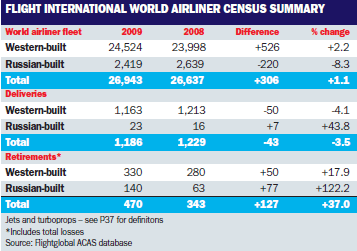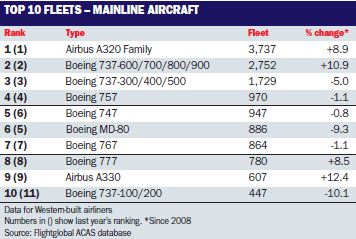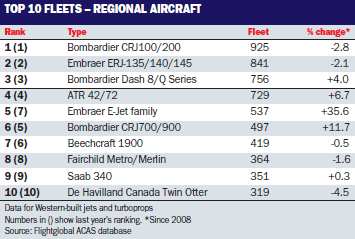The economic downturn has taken its toll on the global airliner fleet over the past 12 months, with growth at a virtual standstill and stored aircraft numbers ballooning to record numbers.
This year's edition of our annual airliner census, which is compiled from the Flightglobal ACAS database, comprises 26,943 aircraft. The global fleet has grown by 306 units over the past 12 months, which at just over 1% is half that of the previous year.
Flightglobal's latest Airliner Census 2009 |
|---|
While the global total includes turboprops and Russian-built airliners, closer examination of the data shows that the growth of the active Western-built jet fleet - probably the most significant barometer for the industry's health - has fallen from 4.4% in 2008 to less than 1%.

Meanwhile, the parked fleet (Western-built jets) has risen by almost 30% in the past 12 months to an all-time high of 2,860. At 13.1%, this is the highest proportion of total Western-built jet fleet ever to be idle.

Predictably, the last time the industry experienced this level of growth in the parked fleet was in 2002-3 after the 9/11 terrorist attacks. In the wake of that event, the idle fleet soared by more than 50% to just over 2,100 aircraft representing around 12.5% of the total fleet.
Over the past year the ACAS database reveals that the active component of the Western-built fleet actually contracted slightly from the 18,700 at July 2008, before growing in recent months to almost 18,900.
New airliner deliveries declined slightly over the past 12 months to 1,186 aircraft, due to the Boeing strike. Meanwhile, deliveries of Russian airliners were up by almost half, but nevertheless reached only 23 units.

Globally, airliner retirements increased significantly to almost 500 aircraft, although it was in the Russian sector that the major increase was experienced. A further rise looks likely in 2009-10 as the economic gloom should ensure that many of the idle Western jets never return from storage.
The geographic fleet composition is generally unchanged, although the Asia, Australasia and Middle East region has seen a slight gain (one percentage point) at the expense of market leaders North/South America and Europe, which have each seen a decline of just under one point. The Asia, Australasia and Middle East region has increased its dominance of the order backlog, with it share rising from 43% to more than 46%.
 |
|---|
© AirbusThe Asian, Australasian and Middle East carriers have seen marketshare gains in fleet numbers and order backlog |
The current generation of single-aisle aircraft from Airbus and Boeing continue to dominate the in-service fleet rankings, with the A320 family still the single biggest fleet, on 3,737 units. The 737NG keeps its second position, albeit almost 1,000 units behind its rival, on 2,752. The combined 737 fleet (including the earlier CFM56-powered variants and the original 737-100/200) is just shy of 5,000 aircraft (4,928). The 737-100/200 has re-entered the top 10 after its trijet sister, the 727, dropped out.
The regional sector reflects the changing fortunes of demand for small and large jets. While 50-seat regional jets are entrenched in first and second place (the Bombardier CRJ is still ahead of the Embraer ERJ), both fleets have declined by more than 2%. The big increases are for the large regional jets, with the CRJ700/900 expanding 12% and the Embraer E-Jets by more than two-thirds - the latter is now the fifth-largest fleet on 537 units.

The Russian-built airliner fleet continues to decline, with an 8% drop in the past 12 months to just over 2,400 aircraft. The Yakovlev Yak-40 regional trijet is now the most numerous type, on 354 units. It has moved ahead of the Antonov An-24 turboprop, which has suffered a greater drop in its fleet numbers. Every one of the top 10 has suffered a drop in fleet count, with the largest being the 30% fall suffered by the ageing Ilyushin Il-62 quadjet.

Boeing leads its rival in the order backlog stakes, and continues to dominate in its home market. However, Airbus retains the upper hand in Europe and Asia, Australasia and Middle East, while things are finely balanced in the African markets. The overall picture is slightly skewed by the fact that a larger proportion of Boeing's backlog is allocated to undisclosed customers, which makes accurate analysis by region difficult.

Boeing's dominance of the manufacturer rankings may not be under threat, but its share is in gradual decline as its fleet size slowly decreases while its main rival from Europe continues to grow. Boeing's 10,858 aircraft, which represent 44% of the total Western-built fleet, is down around 1% on last year. Meanwhile, Airbus has seen its fleet grow by almost 8% (its relatively younger fleet is less affected by retirements than that of its US rival).

Embraer is the other airframer that has seen a big increase, with its fleet growing by more than 7% to 1,700 units thanks to the delivery rate of its E-Jet family. The Brazilian airframer looks on course to be able to boast a larger combined regional jet fleet than Bombardier a year from now.

DATA COMPILED BY JOHN WILDING FLIGHTGLOBAL ACAS RUGBY
Source: Flight International
















